Exploring Stigma and Mental Illness: Challenges and Strategies
VerifiedAdded on 2022/09/25
|9
|2225
|27
Essay
AI Summary
This essay examines the pervasive issue of stigma associated with mental illness, particularly within the Australian context. It explores the multifaceted nature of stigma, encompassing knowledge gaps, behavioral discrimination, and attitudinal prejudice, and its detrimental effects on individuals experiencing depression and anxiety. The paper highlights the importance of a multi-sectoral approach to stigma reduction, including legislative frameworks, such as the Mental Health Statement of Rights and Responsibilities, and initiatives like those by beyondblue. The discussion also addresses nursing implications, emphasizing the crucial role of nurses in early intervention and patient care. The essay concludes by underscoring the need for further research to fully understand the impact of stigma and to inform future care plans and legislation, ultimately aiming to improve the lives of those affected by mental illness.
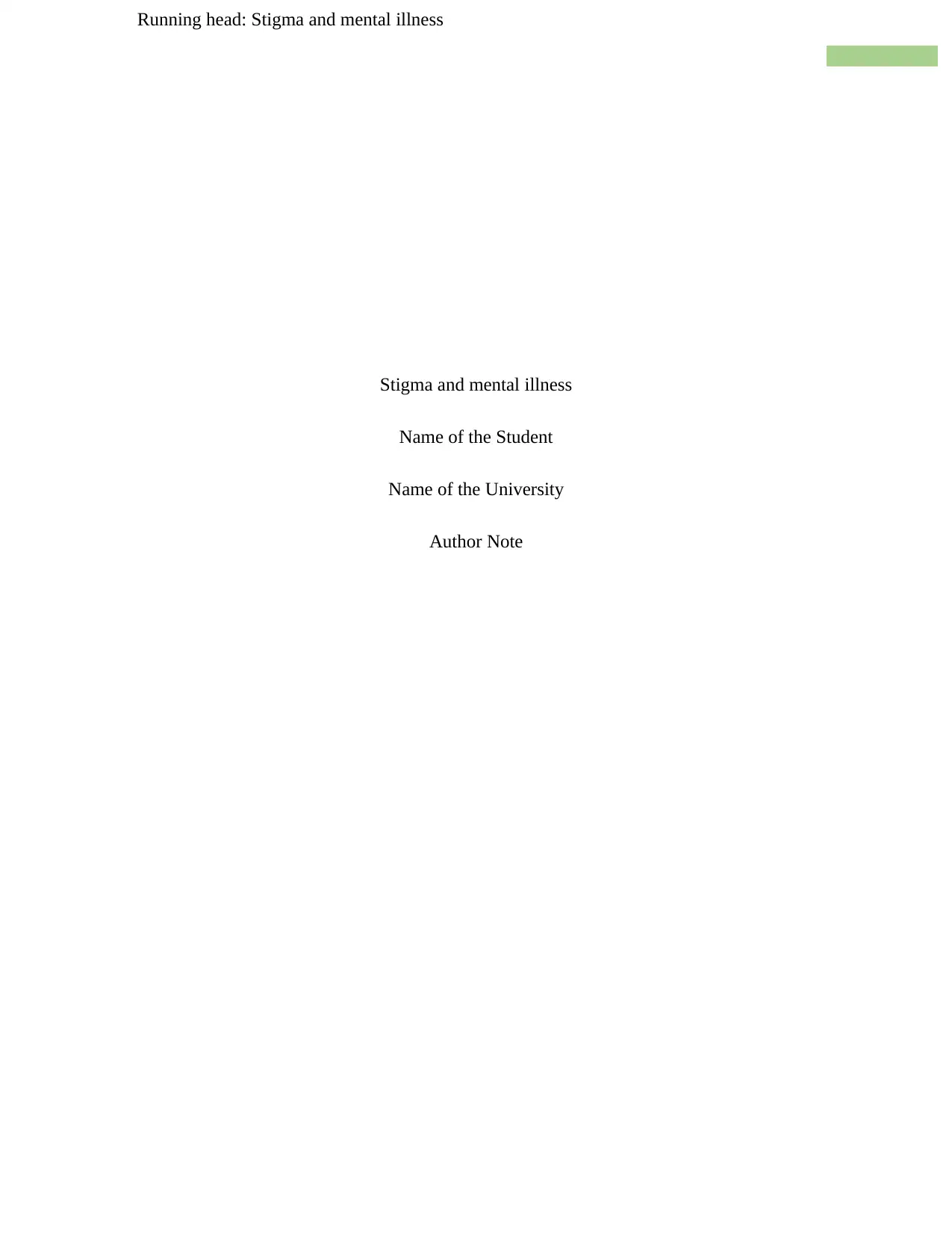
Running head: Stigma and mental illness
Stigma and mental illness
Name of the Student
Name of the University
Author Note
Stigma and mental illness
Name of the Student
Name of the University
Author Note
Paraphrase This Document
Need a fresh take? Get an instant paraphrase of this document with our AI Paraphraser

1
Stigma and mental illness
Introduction
Individuals experiencing depression and anxiety, family and acquaintances face a
tremendous deal of discrimination and stigma. The stigma correlated with anxiety and
depression is complicated – the magnitude, type and interpretation of stigma and discrimination
can be defined by factors such as illness itself, the gender, age and ethnicity of the patient,
culture and the terminology used to describe and explain mental health disorders. Individuals
with depression and anxiety claim that the shame and discrimination they experience might be
worse than their emotional disorders (Tyszkowska & Podogrodzka, 2013). The stigma connected
with depression and anxiety comprises of three components: knowledge challenges (ignorance or
misinformation), behavioral problems (discrimination) and attitude issues (prejudice) and
Improving one aspect may not have an immediate impact on the other components. Nevertheless,
a systemic solution to stigma is required to tackle these three elements. Stigma-reduction
approaches need to be formulated and applied in a coordinated, inclusive and multi-sectoral way
to make significant changes in stigma and prejudice and increase the health outcome of these
patients (beyondblue.org.au, 2015). Thus, this paper will discuss on the effect of stigma on
people with mental health problems and the strategies that are available in Australia to combat
this issue.
Discussion
Stigma and mental health
Stigma is characterized as a negative belief and interpretation of inferior opinions and
discriminatory behaviour. This causes difficulties with the life, contact and jobs for both patients
and their relatives and contributes to inadequate care of patients. In other terms, stigma is a
Stigma and mental illness
Introduction
Individuals experiencing depression and anxiety, family and acquaintances face a
tremendous deal of discrimination and stigma. The stigma correlated with anxiety and
depression is complicated – the magnitude, type and interpretation of stigma and discrimination
can be defined by factors such as illness itself, the gender, age and ethnicity of the patient,
culture and the terminology used to describe and explain mental health disorders. Individuals
with depression and anxiety claim that the shame and discrimination they experience might be
worse than their emotional disorders (Tyszkowska & Podogrodzka, 2013). The stigma connected
with depression and anxiety comprises of three components: knowledge challenges (ignorance or
misinformation), behavioral problems (discrimination) and attitude issues (prejudice) and
Improving one aspect may not have an immediate impact on the other components. Nevertheless,
a systemic solution to stigma is required to tackle these three elements. Stigma-reduction
approaches need to be formulated and applied in a coordinated, inclusive and multi-sectoral way
to make significant changes in stigma and prejudice and increase the health outcome of these
patients (beyondblue.org.au, 2015). Thus, this paper will discuss on the effect of stigma on
people with mental health problems and the strategies that are available in Australia to combat
this issue.
Discussion
Stigma and mental health
Stigma is characterized as a negative belief and interpretation of inferior opinions and
discriminatory behaviour. This causes difficulties with the life, contact and jobs for both patients
and their relatives and contributes to inadequate care of patients. In other terms, stigma is a
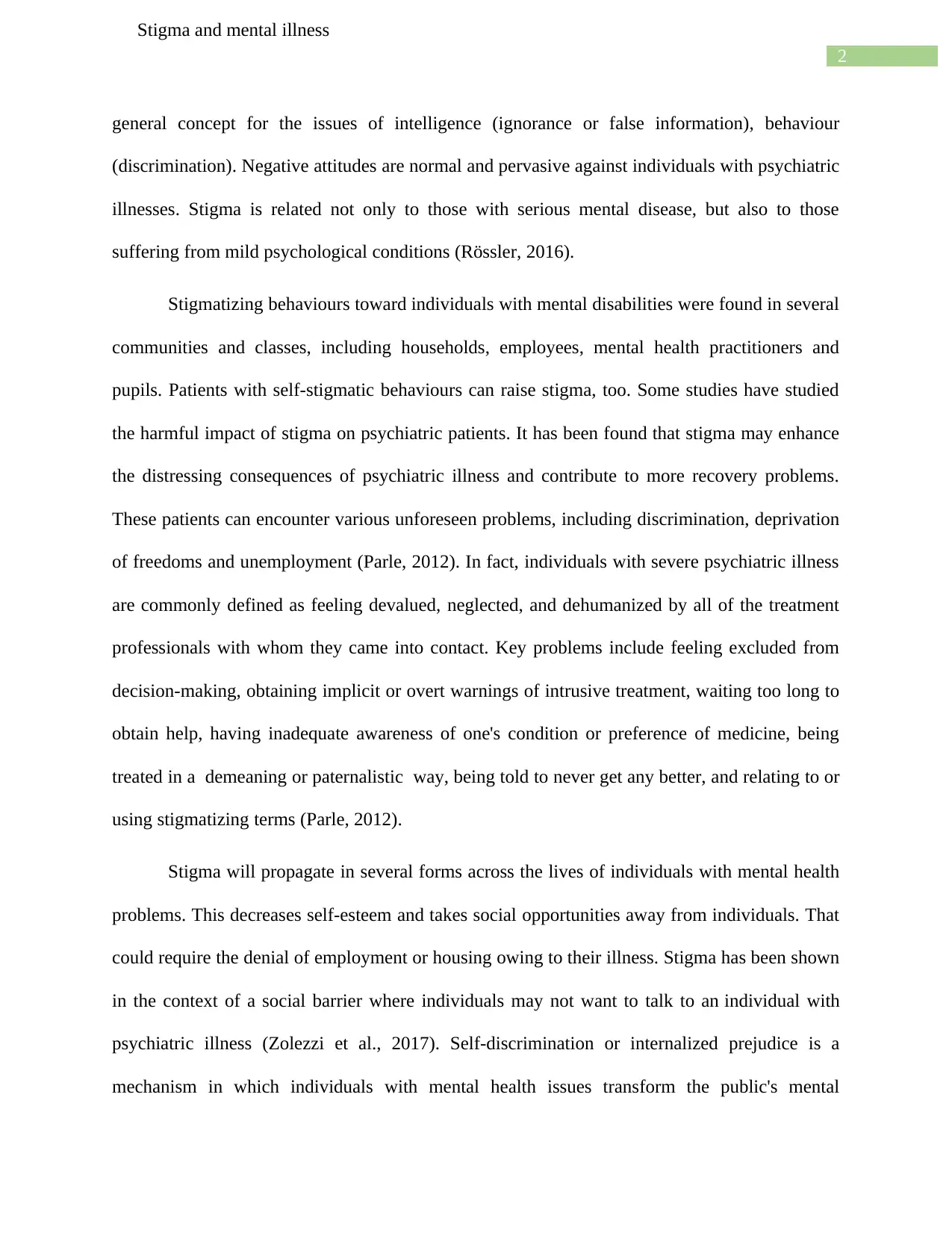
2
Stigma and mental illness
general concept for the issues of intelligence (ignorance or false information), behaviour
(discrimination). Negative attitudes are normal and pervasive against individuals with psychiatric
illnesses. Stigma is related not only to those with serious mental disease, but also to those
suffering from mild psychological conditions (Rössler, 2016).
Stigmatizing behaviours toward individuals with mental disabilities were found in several
communities and classes, including households, employees, mental health practitioners and
pupils. Patients with self-stigmatic behaviours can raise stigma, too. Some studies have studied
the harmful impact of stigma on psychiatric patients. It has been found that stigma may enhance
the distressing consequences of psychiatric illness and contribute to more recovery problems.
These patients can encounter various unforeseen problems, including discrimination, deprivation
of freedoms and unemployment (Parle, 2012). In fact, individuals with severe psychiatric illness
are commonly defined as feeling devalued, neglected, and dehumanized by all of the treatment
professionals with whom they came into contact. Key problems include feeling excluded from
decision-making, obtaining implicit or overt warnings of intrusive treatment, waiting too long to
obtain help, having inadequate awareness of one's condition or preference of medicine, being
treated in a demeaning or paternalistic way, being told to never get any better, and relating to or
using stigmatizing terms (Parle, 2012).
Stigma will propagate in several forms across the lives of individuals with mental health
problems. This decreases self-esteem and takes social opportunities away from individuals. That
could require the denial of employment or housing owing to their illness. Stigma has been shown
in the context of a social barrier where individuals may not want to talk to an individual with
psychiatric illness (Zolezzi et al., 2017). Self-discrimination or internalized prejudice is a
mechanism in which individuals with mental health issues transform the public's mental
Stigma and mental illness
general concept for the issues of intelligence (ignorance or false information), behaviour
(discrimination). Negative attitudes are normal and pervasive against individuals with psychiatric
illnesses. Stigma is related not only to those with serious mental disease, but also to those
suffering from mild psychological conditions (Rössler, 2016).
Stigmatizing behaviours toward individuals with mental disabilities were found in several
communities and classes, including households, employees, mental health practitioners and
pupils. Patients with self-stigmatic behaviours can raise stigma, too. Some studies have studied
the harmful impact of stigma on psychiatric patients. It has been found that stigma may enhance
the distressing consequences of psychiatric illness and contribute to more recovery problems.
These patients can encounter various unforeseen problems, including discrimination, deprivation
of freedoms and unemployment (Parle, 2012). In fact, individuals with severe psychiatric illness
are commonly defined as feeling devalued, neglected, and dehumanized by all of the treatment
professionals with whom they came into contact. Key problems include feeling excluded from
decision-making, obtaining implicit or overt warnings of intrusive treatment, waiting too long to
obtain help, having inadequate awareness of one's condition or preference of medicine, being
treated in a demeaning or paternalistic way, being told to never get any better, and relating to or
using stigmatizing terms (Parle, 2012).
Stigma will propagate in several forms across the lives of individuals with mental health
problems. This decreases self-esteem and takes social opportunities away from individuals. That
could require the denial of employment or housing owing to their illness. Stigma has been shown
in the context of a social barrier where individuals may not want to talk to an individual with
psychiatric illness (Zolezzi et al., 2017). Self-discrimination or internalized prejudice is a
mechanism in which individuals with mental health issues transform the public's mental
⊘ This is a preview!⊘
Do you want full access?
Subscribe today to unlock all pages.

Trusted by 1+ million students worldwide
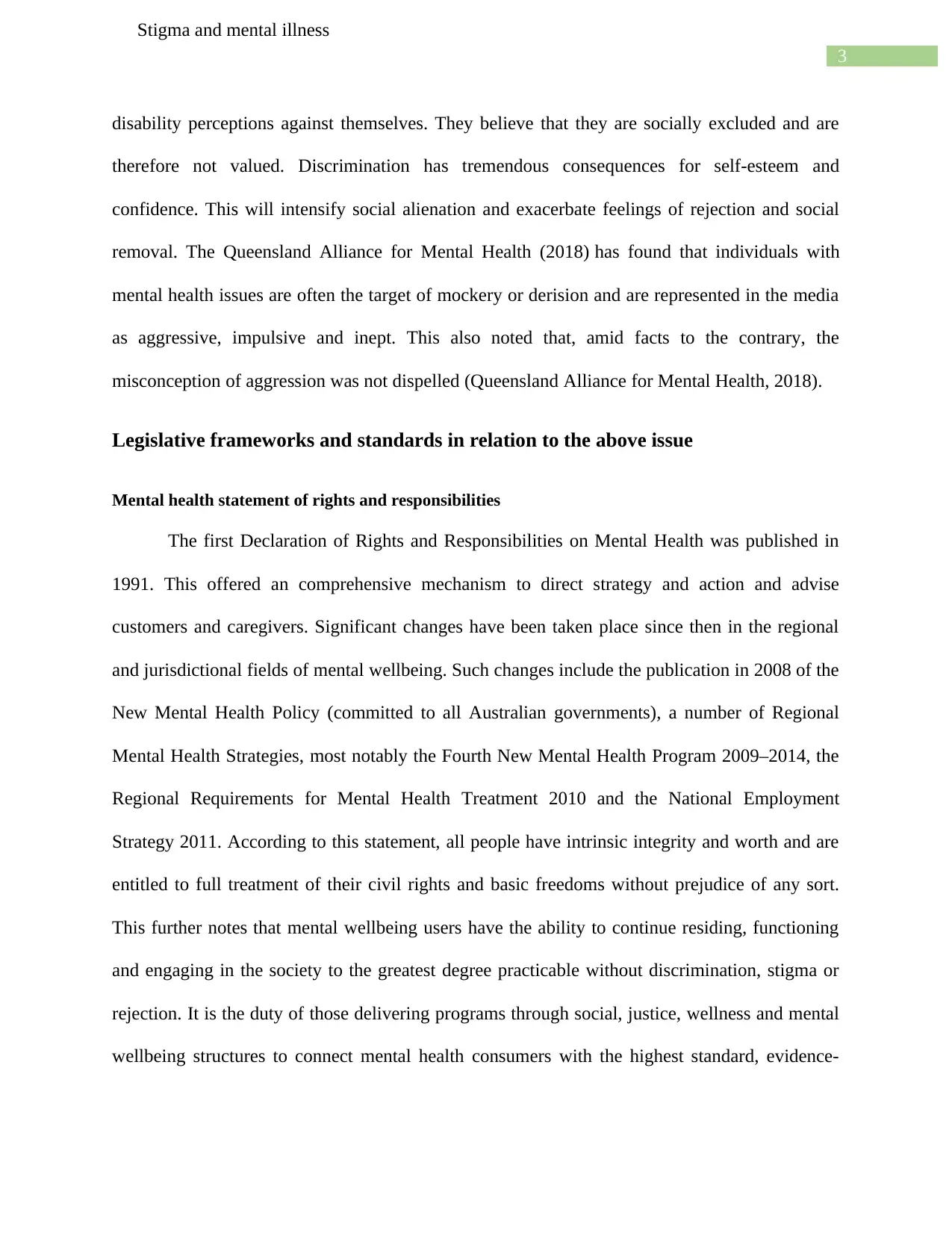
3
Stigma and mental illness
disability perceptions against themselves. They believe that they are socially excluded and are
therefore not valued. Discrimination has tremendous consequences for self-esteem and
confidence. This will intensify social alienation and exacerbate feelings of rejection and social
removal. The Queensland Alliance for Mental Health (2018) has found that individuals with
mental health issues are often the target of mockery or derision and are represented in the media
as aggressive, impulsive and inept. This also noted that, amid facts to the contrary, the
misconception of aggression was not dispelled (Queensland Alliance for Mental Health, 2018).
Legislative frameworks and standards in relation to the above issue
Mental health statement of rights and responsibilities
The first Declaration of Rights and Responsibilities on Mental Health was published in
1991. This offered an comprehensive mechanism to direct strategy and action and advise
customers and caregivers. Significant changes have been taken place since then in the regional
and jurisdictional fields of mental wellbeing. Such changes include the publication in 2008 of the
New Mental Health Policy (committed to all Australian governments), a number of Regional
Mental Health Strategies, most notably the Fourth New Mental Health Program 2009–2014, the
Regional Requirements for Mental Health Treatment 2010 and the National Employment
Strategy 2011. According to this statement, all people have intrinsic integrity and worth and are
entitled to full treatment of their civil rights and basic freedoms without prejudice of any sort.
This further notes that mental wellbeing users have the ability to continue residing, functioning
and engaging in the society to the greatest degree practicable without discrimination, stigma or
rejection. It is the duty of those delivering programs through social, justice, wellness and mental
wellbeing structures to connect mental health consumers with the highest standard, evidence-
Stigma and mental illness
disability perceptions against themselves. They believe that they are socially excluded and are
therefore not valued. Discrimination has tremendous consequences for self-esteem and
confidence. This will intensify social alienation and exacerbate feelings of rejection and social
removal. The Queensland Alliance for Mental Health (2018) has found that individuals with
mental health issues are often the target of mockery or derision and are represented in the media
as aggressive, impulsive and inept. This also noted that, amid facts to the contrary, the
misconception of aggression was not dispelled (Queensland Alliance for Mental Health, 2018).
Legislative frameworks and standards in relation to the above issue
Mental health statement of rights and responsibilities
The first Declaration of Rights and Responsibilities on Mental Health was published in
1991. This offered an comprehensive mechanism to direct strategy and action and advise
customers and caregivers. Significant changes have been taken place since then in the regional
and jurisdictional fields of mental wellbeing. Such changes include the publication in 2008 of the
New Mental Health Policy (committed to all Australian governments), a number of Regional
Mental Health Strategies, most notably the Fourth New Mental Health Program 2009–2014, the
Regional Requirements for Mental Health Treatment 2010 and the National Employment
Strategy 2011. According to this statement, all people have intrinsic integrity and worth and are
entitled to full treatment of their civil rights and basic freedoms without prejudice of any sort.
This further notes that mental wellbeing users have the ability to continue residing, functioning
and engaging in the society to the greatest degree practicable without discrimination, stigma or
rejection. It is the duty of those delivering programs through social, justice, wellness and mental
wellbeing structures to connect mental health consumers with the highest standard, evidence-
Paraphrase This Document
Need a fresh take? Get an instant paraphrase of this document with our AI Paraphraser

4
Stigma and mental illness
based, best practice, evaluation, individualized care preparation, assistance, care, diagnosis,
prevention and healing services without stigma and discrimination (health.gov.au, 2012).
beyondblue initiatives addressing stigma and discrimination
One of the goals of beyondblue is raising people's perception of stigma and prejudice. To
this end, beyondblue is creating a full range of stigma-reduction approaches targeted at specific
demographic populations and environments and focused on 'what works'. In collaboration with
individuals experiencing depression and anxiety and families and friends, these approaches will
begin to be created and enforced to further alleviate stigma and prejudice and enhance the
quality life of depression and anxiety-afflicted individuals. Reducing people's views of stigma
and inequality is one of the beyond-blue goals of the 2015-2020 Strategic Program. This five-
year strategic vision focuses on the basic idea around which beyondblue was established to
create awareness in the community about psychiatric disorder, minimize stigma correlated with
mental illness, and promote a healthy environment. beyondblue decreases the impact of stigma
and discrimination on people's ability to receive treatment for themselves or those who may
suffer stress, anxiety, or are at risk of suicide. beyondblue's mission is to guarantee that everyone
in Australia enjoys their highest overall mental wellbeing. By their community resources,
projects, study, advocacy and communication activities, they break down stigma, bias and
discrimination that serve as obstacles to individuals seeking help. They drive improvement to
preserve everyone's mental wellbeing and to strengthen the lives of people, families and societies
impacted by fear, depression and suicide (beyondblue.org.au, 2015).
Nursing Implications
Many aspects of people's lives may be influenced by stigma. Even a brief period of
psychiatric illness has far-reaching consequences, not just on patients' wellbeing, but may also
Stigma and mental illness
based, best practice, evaluation, individualized care preparation, assistance, care, diagnosis,
prevention and healing services without stigma and discrimination (health.gov.au, 2012).
beyondblue initiatives addressing stigma and discrimination
One of the goals of beyondblue is raising people's perception of stigma and prejudice. To
this end, beyondblue is creating a full range of stigma-reduction approaches targeted at specific
demographic populations and environments and focused on 'what works'. In collaboration with
individuals experiencing depression and anxiety and families and friends, these approaches will
begin to be created and enforced to further alleviate stigma and prejudice and enhance the
quality life of depression and anxiety-afflicted individuals. Reducing people's views of stigma
and inequality is one of the beyond-blue goals of the 2015-2020 Strategic Program. This five-
year strategic vision focuses on the basic idea around which beyondblue was established to
create awareness in the community about psychiatric disorder, minimize stigma correlated with
mental illness, and promote a healthy environment. beyondblue decreases the impact of stigma
and discrimination on people's ability to receive treatment for themselves or those who may
suffer stress, anxiety, or are at risk of suicide. beyondblue's mission is to guarantee that everyone
in Australia enjoys their highest overall mental wellbeing. By their community resources,
projects, study, advocacy and communication activities, they break down stigma, bias and
discrimination that serve as obstacles to individuals seeking help. They drive improvement to
preserve everyone's mental wellbeing and to strengthen the lives of people, families and societies
impacted by fear, depression and suicide (beyondblue.org.au, 2015).
Nursing Implications
Many aspects of people's lives may be influenced by stigma. Even a brief period of
psychiatric illness has far-reaching consequences, not just on patients' wellbeing, but may also
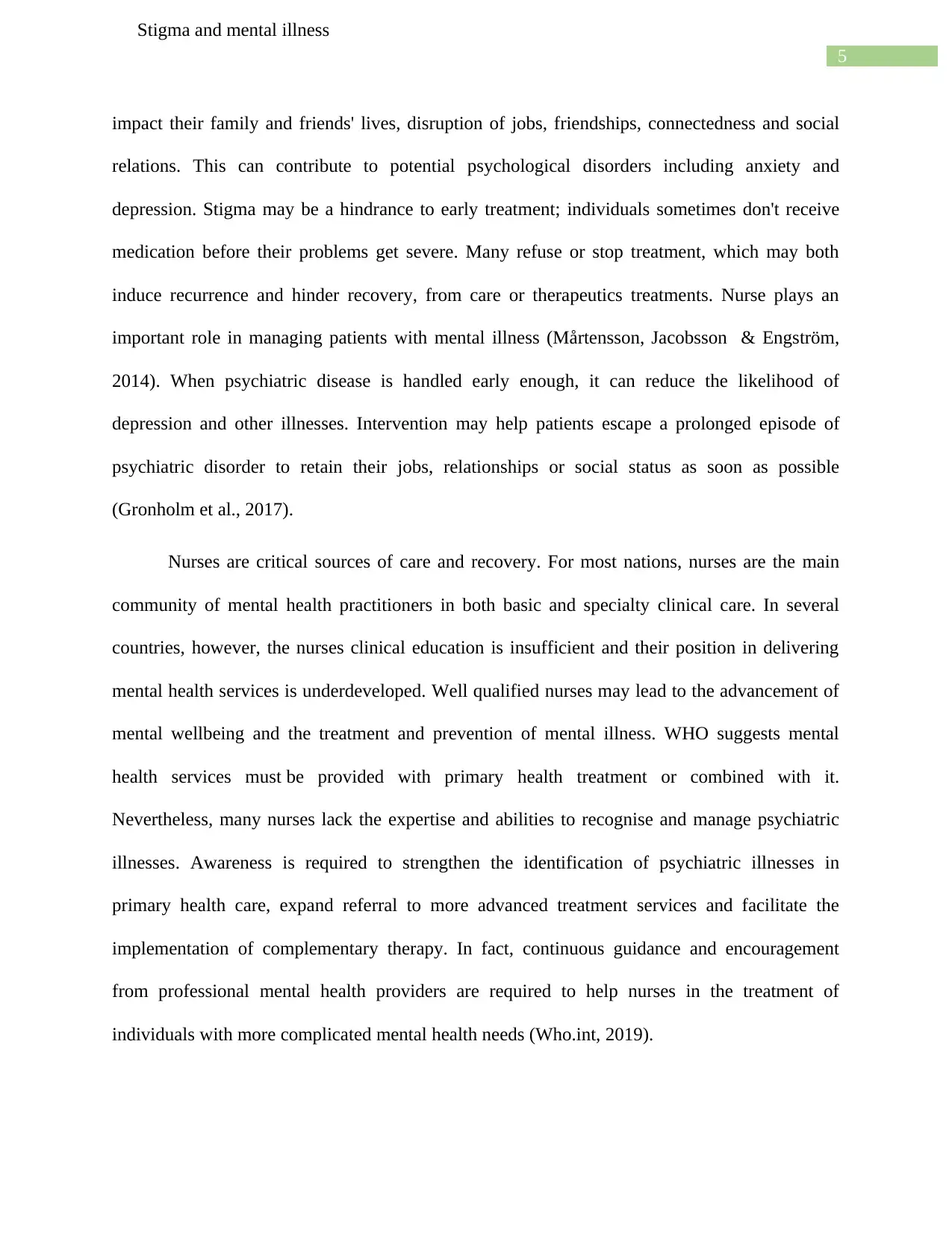
5
Stigma and mental illness
impact their family and friends' lives, disruption of jobs, friendships, connectedness and social
relations. This can contribute to potential psychological disorders including anxiety and
depression. Stigma may be a hindrance to early treatment; individuals sometimes don't receive
medication before their problems get severe. Many refuse or stop treatment, which may both
induce recurrence and hinder recovery, from care or therapeutics treatments. Nurse plays an
important role in managing patients with mental illness (Mårtensson, Jacobsson & Engström,
2014). When psychiatric disease is handled early enough, it can reduce the likelihood of
depression and other illnesses. Intervention may help patients escape a prolonged episode of
psychiatric disorder to retain their jobs, relationships or social status as soon as possible
(Gronholm et al., 2017).
Nurses are critical sources of care and recovery. For most nations, nurses are the main
community of mental health practitioners in both basic and specialty clinical care. In several
countries, however, the nurses clinical education is insufficient and their position in delivering
mental health services is underdeveloped. Well qualified nurses may lead to the advancement of
mental wellbeing and the treatment and prevention of mental illness. WHO suggests mental
health services must be provided with primary health treatment or combined with it.
Nevertheless, many nurses lack the expertise and abilities to recognise and manage psychiatric
illnesses. Awareness is required to strengthen the identification of psychiatric illnesses in
primary health care, expand referral to more advanced treatment services and facilitate the
implementation of complementary therapy. In fact, continuous guidance and encouragement
from professional mental health providers are required to help nurses in the treatment of
individuals with more complicated mental health needs (Who.int, 2019).
Stigma and mental illness
impact their family and friends' lives, disruption of jobs, friendships, connectedness and social
relations. This can contribute to potential psychological disorders including anxiety and
depression. Stigma may be a hindrance to early treatment; individuals sometimes don't receive
medication before their problems get severe. Many refuse or stop treatment, which may both
induce recurrence and hinder recovery, from care or therapeutics treatments. Nurse plays an
important role in managing patients with mental illness (Mårtensson, Jacobsson & Engström,
2014). When psychiatric disease is handled early enough, it can reduce the likelihood of
depression and other illnesses. Intervention may help patients escape a prolonged episode of
psychiatric disorder to retain their jobs, relationships or social status as soon as possible
(Gronholm et al., 2017).
Nurses are critical sources of care and recovery. For most nations, nurses are the main
community of mental health practitioners in both basic and specialty clinical care. In several
countries, however, the nurses clinical education is insufficient and their position in delivering
mental health services is underdeveloped. Well qualified nurses may lead to the advancement of
mental wellbeing and the treatment and prevention of mental illness. WHO suggests mental
health services must be provided with primary health treatment or combined with it.
Nevertheless, many nurses lack the expertise and abilities to recognise and manage psychiatric
illnesses. Awareness is required to strengthen the identification of psychiatric illnesses in
primary health care, expand referral to more advanced treatment services and facilitate the
implementation of complementary therapy. In fact, continuous guidance and encouragement
from professional mental health providers are required to help nurses in the treatment of
individuals with more complicated mental health needs (Who.int, 2019).
⊘ This is a preview!⊘
Do you want full access?
Subscribe today to unlock all pages.

Trusted by 1+ million students worldwide

6
Stigma and mental illness
Conclusion
The research shows that public opinion of people with mental health issues remains
negative. No significant change has occurred in the public perception of mental illness despite
national campaigns. While substantial work has been done on the understanding of mental illness
by the media, further studies are need which will investigate the perspectives of facilities
consumers and their families, caregivers and their families to identify and quantify the effect of
stigma on their lives. Stigma may be a deterrent to obtaining early therapy; individuals
sometimes do not receive medical treatment until their problems become severe. Some may drop
out of treatment or medical treatments or avoid taking medicine, both of which can induce
relapse and delay rehabilitation. While comprehensive work was carried out in order to examine
the public's view of mental illness, further studies will investigate the perspectives and the
impact of the stigma on their life of service recipients and their friends, carers and those near to
them. In order to develop future care plan and formulate legislation, more research needs to be
undertaken for individuals who have clear knowledge with mental disability in order to get a
deeper understanding of the effect of stigma on their lives.
Stigma and mental illness
Conclusion
The research shows that public opinion of people with mental health issues remains
negative. No significant change has occurred in the public perception of mental illness despite
national campaigns. While substantial work has been done on the understanding of mental illness
by the media, further studies are need which will investigate the perspectives of facilities
consumers and their families, caregivers and their families to identify and quantify the effect of
stigma on their lives. Stigma may be a deterrent to obtaining early therapy; individuals
sometimes do not receive medical treatment until their problems become severe. Some may drop
out of treatment or medical treatments or avoid taking medicine, both of which can induce
relapse and delay rehabilitation. While comprehensive work was carried out in order to examine
the public's view of mental illness, further studies will investigate the perspectives and the
impact of the stigma on their life of service recipients and their friends, carers and those near to
them. In order to develop future care plan and formulate legislation, more research needs to be
undertaken for individuals who have clear knowledge with mental disability in order to get a
deeper understanding of the effect of stigma on their lives.
Paraphrase This Document
Need a fresh take? Get an instant paraphrase of this document with our AI Paraphraser
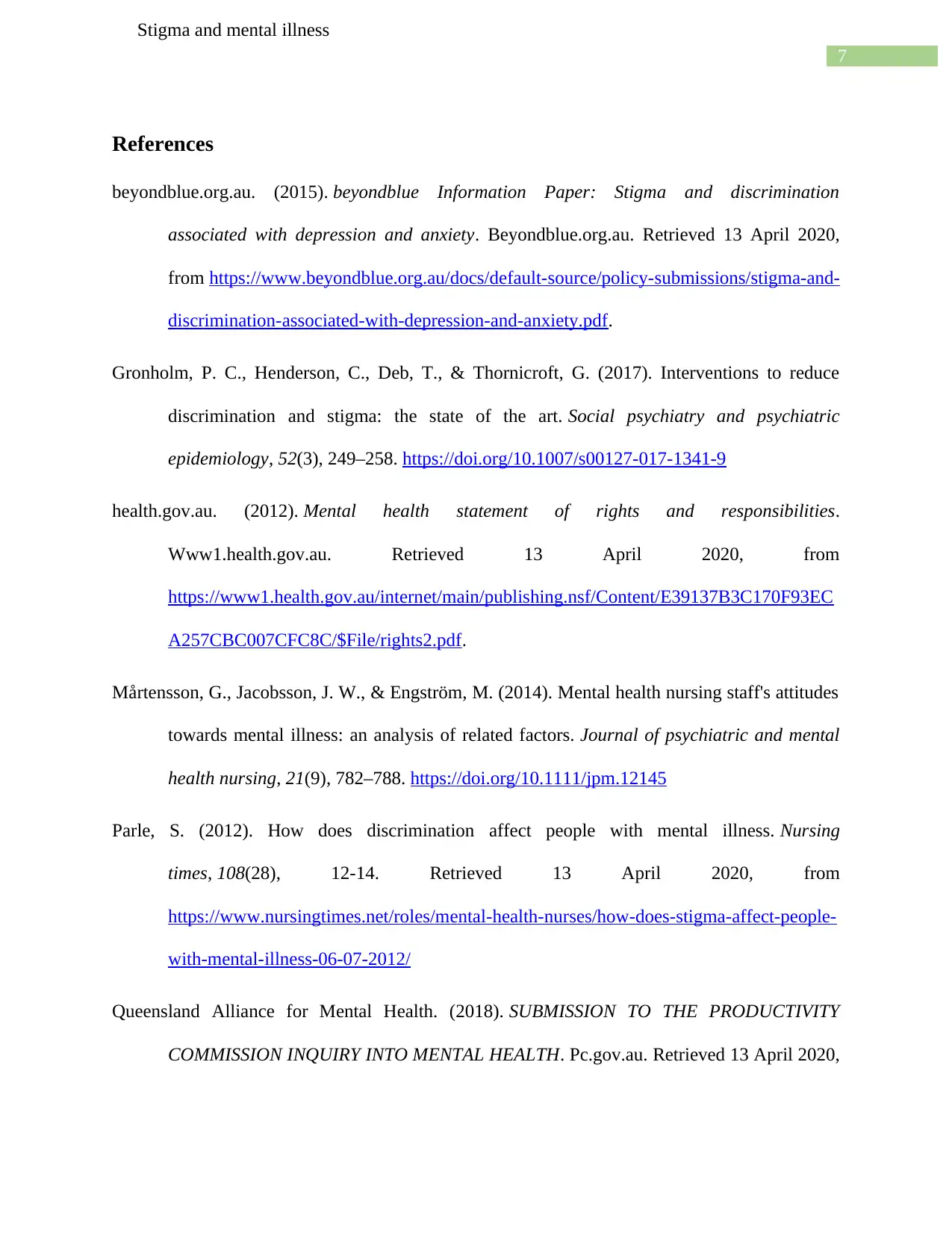
7
Stigma and mental illness
References
beyondblue.org.au. (2015). beyondblue Information Paper: Stigma and discrimination
associated with depression and anxiety. Beyondblue.org.au. Retrieved 13 April 2020,
from https://www.beyondblue.org.au/docs/default-source/policy-submissions/stigma-and-
discrimination-associated-with-depression-and-anxiety.pdf.
Gronholm, P. C., Henderson, C., Deb, T., & Thornicroft, G. (2017). Interventions to reduce
discrimination and stigma: the state of the art. Social psychiatry and psychiatric
epidemiology, 52(3), 249–258. https://doi.org/10.1007/s00127-017-1341-9
health.gov.au. (2012). Mental health statement of rights and responsibilities.
Www1.health.gov.au. Retrieved 13 April 2020, from
https://www1.health.gov.au/internet/main/publishing.nsf/Content/E39137B3C170F93EC
A257CBC007CFC8C/$File/rights2.pdf.
Mårtensson, G., Jacobsson, J. W., & Engström, M. (2014). Mental health nursing staff's attitudes
towards mental illness: an analysis of related factors. Journal of psychiatric and mental
health nursing, 21(9), 782–788. https://doi.org/10.1111/jpm.12145
Parle, S. (2012). How does discrimination affect people with mental illness. Nursing
times, 108(28), 12-14. Retrieved 13 April 2020, from
https://www.nursingtimes.net/roles/mental-health-nurses/how-does-stigma-affect-people-
with-mental-illness-06-07-2012/
Queensland Alliance for Mental Health. (2018). SUBMISSION TO THE PRODUCTIVITY
COMMISSION INQUIRY INTO MENTAL HEALTH. Pc.gov.au. Retrieved 13 April 2020,
Stigma and mental illness
References
beyondblue.org.au. (2015). beyondblue Information Paper: Stigma and discrimination
associated with depression and anxiety. Beyondblue.org.au. Retrieved 13 April 2020,
from https://www.beyondblue.org.au/docs/default-source/policy-submissions/stigma-and-
discrimination-associated-with-depression-and-anxiety.pdf.
Gronholm, P. C., Henderson, C., Deb, T., & Thornicroft, G. (2017). Interventions to reduce
discrimination and stigma: the state of the art. Social psychiatry and psychiatric
epidemiology, 52(3), 249–258. https://doi.org/10.1007/s00127-017-1341-9
health.gov.au. (2012). Mental health statement of rights and responsibilities.
Www1.health.gov.au. Retrieved 13 April 2020, from
https://www1.health.gov.au/internet/main/publishing.nsf/Content/E39137B3C170F93EC
A257CBC007CFC8C/$File/rights2.pdf.
Mårtensson, G., Jacobsson, J. W., & Engström, M. (2014). Mental health nursing staff's attitudes
towards mental illness: an analysis of related factors. Journal of psychiatric and mental
health nursing, 21(9), 782–788. https://doi.org/10.1111/jpm.12145
Parle, S. (2012). How does discrimination affect people with mental illness. Nursing
times, 108(28), 12-14. Retrieved 13 April 2020, from
https://www.nursingtimes.net/roles/mental-health-nurses/how-does-stigma-affect-people-
with-mental-illness-06-07-2012/
Queensland Alliance for Mental Health. (2018). SUBMISSION TO THE PRODUCTIVITY
COMMISSION INQUIRY INTO MENTAL HEALTH. Pc.gov.au. Retrieved 13 April 2020,
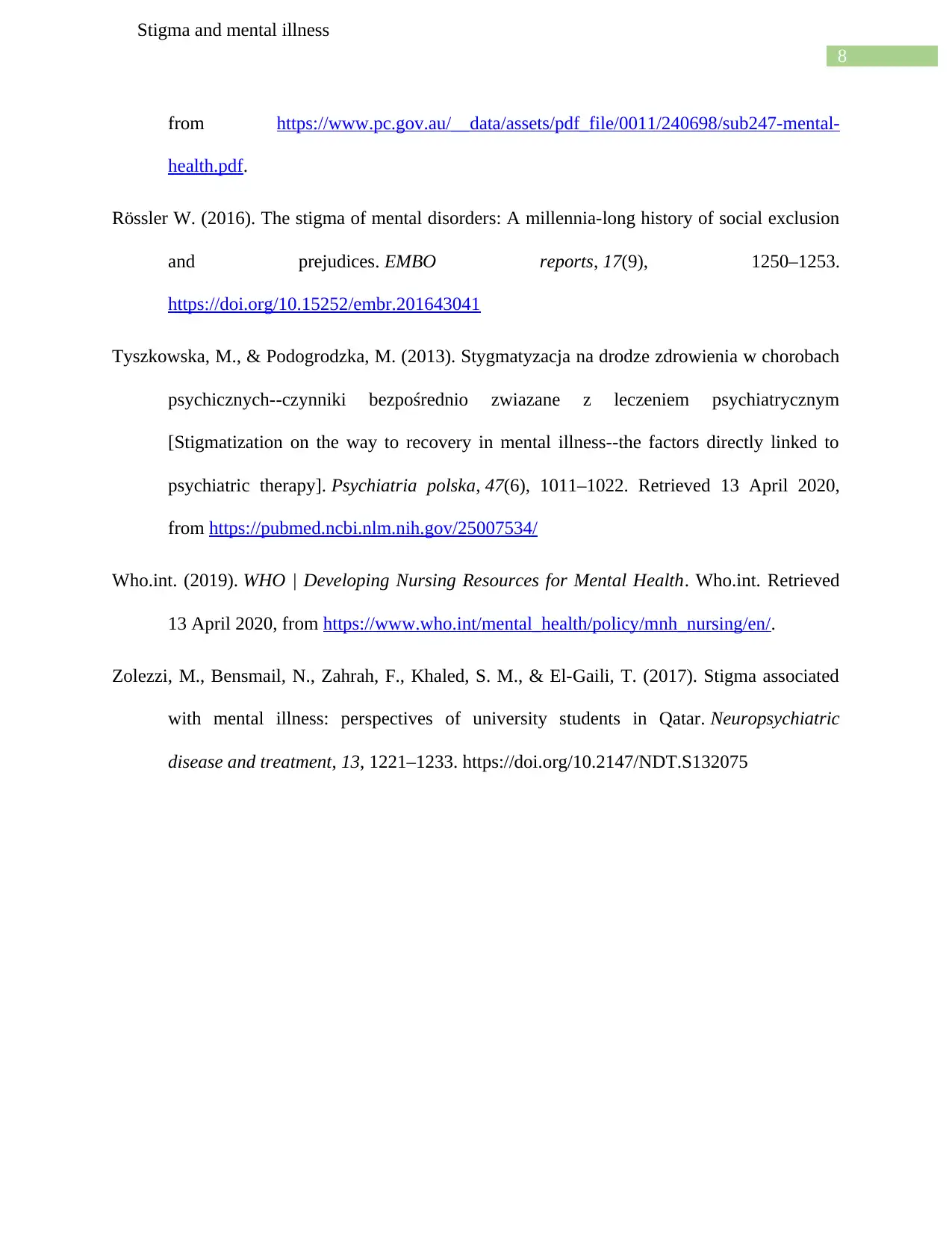
8
Stigma and mental illness
from https://www.pc.gov.au/__data/assets/pdf_file/0011/240698/sub247-mental-
health.pdf.
Rössler W. (2016). The stigma of mental disorders: A millennia-long history of social exclusion
and prejudices. EMBO reports, 17(9), 1250–1253.
https://doi.org/10.15252/embr.201643041
Tyszkowska, M., & Podogrodzka, M. (2013). Stygmatyzacja na drodze zdrowienia w chorobach
psychicznych--czynniki bezpośrednio zwiazane z leczeniem psychiatrycznym
[Stigmatization on the way to recovery in mental illness--the factors directly linked to
psychiatric therapy]. Psychiatria polska, 47(6), 1011–1022. Retrieved 13 April 2020,
from https://pubmed.ncbi.nlm.nih.gov/25007534/
Who.int. (2019). WHO | Developing Nursing Resources for Mental Health. Who.int. Retrieved
13 April 2020, from https://www.who.int/mental_health/policy/mnh_nursing/en/.
Zolezzi, M., Bensmail, N., Zahrah, F., Khaled, S. M., & El-Gaili, T. (2017). Stigma associated
with mental illness: perspectives of university students in Qatar. Neuropsychiatric
disease and treatment, 13, 1221–1233. https://doi.org/10.2147/NDT.S132075
Stigma and mental illness
from https://www.pc.gov.au/__data/assets/pdf_file/0011/240698/sub247-mental-
health.pdf.
Rössler W. (2016). The stigma of mental disorders: A millennia-long history of social exclusion
and prejudices. EMBO reports, 17(9), 1250–1253.
https://doi.org/10.15252/embr.201643041
Tyszkowska, M., & Podogrodzka, M. (2013). Stygmatyzacja na drodze zdrowienia w chorobach
psychicznych--czynniki bezpośrednio zwiazane z leczeniem psychiatrycznym
[Stigmatization on the way to recovery in mental illness--the factors directly linked to
psychiatric therapy]. Psychiatria polska, 47(6), 1011–1022. Retrieved 13 April 2020,
from https://pubmed.ncbi.nlm.nih.gov/25007534/
Who.int. (2019). WHO | Developing Nursing Resources for Mental Health. Who.int. Retrieved
13 April 2020, from https://www.who.int/mental_health/policy/mnh_nursing/en/.
Zolezzi, M., Bensmail, N., Zahrah, F., Khaled, S. M., & El-Gaili, T. (2017). Stigma associated
with mental illness: perspectives of university students in Qatar. Neuropsychiatric
disease and treatment, 13, 1221–1233. https://doi.org/10.2147/NDT.S132075
⊘ This is a preview!⊘
Do you want full access?
Subscribe today to unlock all pages.

Trusted by 1+ million students worldwide
1 out of 9
Related Documents
Your All-in-One AI-Powered Toolkit for Academic Success.
+13062052269
info@desklib.com
Available 24*7 on WhatsApp / Email
![[object Object]](/_next/static/media/star-bottom.7253800d.svg)
Unlock your academic potential
Copyright © 2020–2025 A2Z Services. All Rights Reserved. Developed and managed by ZUCOL.





